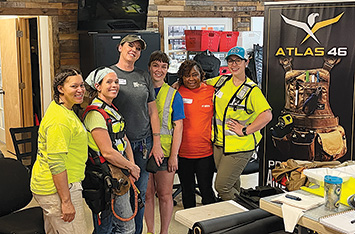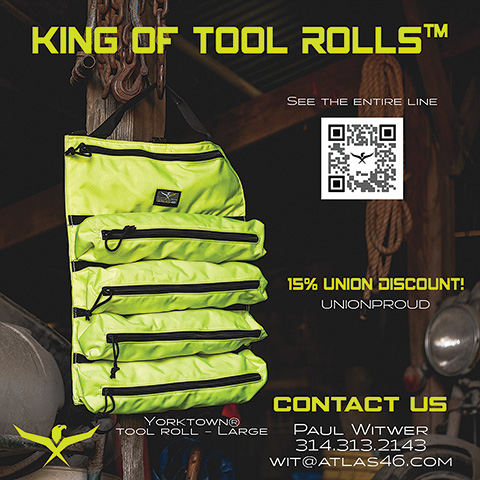
Fenton company working on line of clothing for women in building trades
A group of six local, journey-level tradeswomen recently participated in a focus group study about an issue they frequently encounter that few companies in the United States have addressed: workwear and gear created specifically for women in construction.
But Atlas 46, a construction soft goods manufacturer in Fenton, Mo. founded in 1974, is hoping to change that with a line of American-made clothing designed specifically for tradeswomen.
WORKING TO FILL THE VOID
“We recognize what a dilemma you’re facing,” Paul Witwer, Atlas 46 vice president of business development, shared with the group at the June 14 meeting. “It’s not going to happen overnight, but we’re in this with you and we are working to fill the void.”
The tradeswomen sat down with members of the company’s research and design departments to talk candidly about what they need when it comes to work clothes. The tradeswomen panel included:
- Aurora Bihler, program coordinator of the Building Union Diversity (BUD) program, of Iron Workers Local 396.
- Dawn Fleming, vice president of Missouri Women in Trades (MOWIT), of Carpenters Local 97.
- Delicia Simpson, of Laborers Local 110.
- Jess Fowler, of Iron Workers Local 396.
- Lexi Knapp, of Plumbers & Pipefitters Local 562.
- Serena Lewis-Kelley, of Sheet Metal Workers Local 268.
SAFETY IS KEY
A concern expressed repeated by the group was safety. Because the construction field is a male-dominated industry, workwear and gear is designed for men, and simply put, men’s clothing doesn’t fit most women. Women typically have smaller frames and are shaplier.
“Safety starts with what you wear,” Fleming pointed out. “What is designed for men is not necessarily safe for women.”
For example, when you’re working on a building 500 feet in the air, its detrimental not to have a properly fitted harness, and if you’re a 5 foot 1″ woman who is 110 pounds, a man’s size small just isn’t going to cut it.
Same scenario with gloves. A man’s size small may fit a petite woman’s hands like a size large and loose material can spell disaster when you’re working with tools, equipment and other heavy machinery.
WORK PANTS
Bihler said one of the hardest things for her is finding work pants that fit properly and being able to try them on before she buys.
“A lot of times you have to go to the thrift stores and try on men’s pants or you’re forced to order from a store website and hope the clothing fits,” she said. “Plus, a lot of the workwear isn’t American made and the markup for women’s pants is insane. You wouldn’t think it would be because there’s usually less material needed.”
Simpson agreed with Bihler. She too has to buy men’s pants. She is 5 foot 2 and has a tough time finding pants that are flexible, have side pockets and are short enough.
BOOTS
Bihler said another item that’s tough to find are women’s boots.
“Very few options are available for women and the smallest size men’s boot you can find is usually a size 8, which is a size 10 in a women’s boot,” Bihler explained.
NUMBER OF TRADESWOMEN SKYROCKETING
In 2021, the number of women working in trades occupations reached the highest level ever, at just over 314,000, according to the Institute for Women’s Policy Research (IWPR). During the last five years, the number of tradeswomen increased by almost one-third (32.1 percent).
And while tradeswomen make up only 3.9 percent of those who work with the tools in the construction industry, IWPR contends that these trends show that construction careers are attracting an increasing number of women.
A MOVEMENT
Lewis-Kelley noted that the number of women joining the trades isn’t just a fad or trend, it’s a movement.
“We are not going anywhere, and we are here to stay,” she said.
PRELIMINARY DESIGNS
Witwer said the company is working on some preliminary designs to share with the tradeswomen in the focus group.
The Labor Tribune will be following this important work and providing timely updates.


